Category Archives: AI
Why Deep Learning is called Deep Learning?
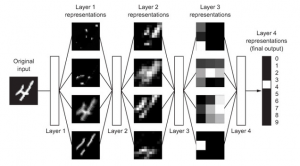
In this post, you will learn why deep learning is called as deep learning. You may recall that deep learning is a subfield of machine learning. One of the key difference between deep learning and machine learning is in the manner the representations / features of data is learnt. In machine learning, the representations of data need to be hand-crafted by the data scientists. In deep learning, the representations of data is learnt automatically as part of learning process. As a matter of fact, in deep learning, layered representations of data is learnt. The layered representations of data are learnt via models called as neural networks. The diagram below represents …
Difference – Artificial Intelligence & Machine Learning
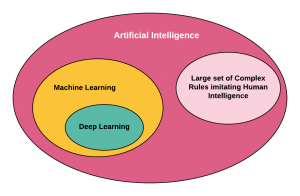
In this post, you learn the difference between artificial intelligence & machine learning. Artificial intelligence represents a set of computer programs that imitate human intelligence. The diagram below represents the key difference between AI and Machine Learning. Basically, machine learning is a part of AI landscape. One can do AI without doing machine learning or deep learning. Thus, an organization can claim that they have AI-based systems without having machine learning or deep learning based systems. All machine learning or deep learning based systems can be termed as AI systems. But, all AI systems may not be termed as machine learning systems. The following are key building blocks of an …
Machine Learning Models Evaluation Infographics
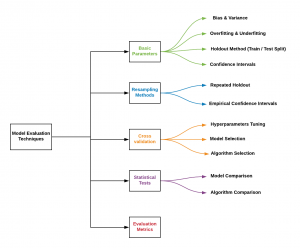
In this post, you will get an access to a self-explanatory infographics / diagram representing different aspects / techniques which need to be considered while doing machine learning model evaluation. Here is the infographics: In the above diagram, you will notice that the following needs to be considered once the model is trained. This is required to be done to select one model out of many models which get trained. Basic parameters: The following need to be considered for evaluating the model: Bias & variance Overfitting & underfitting Holdout method Confidence intervals Resampling methods: The following techniques need to be adopted for evaluating models: Repeated holdout Empirical confidence intervals Cross-validation: Cross …
Infographics for Model & Algorithm Selection & Evaluation
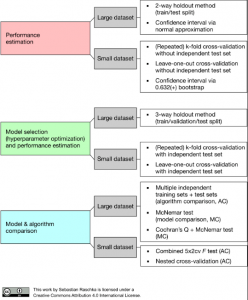
This is a short post created for quick reference on techniques which could be used for model evaluation & selection and model and algorithm comparision. This would be very helpful for those aspiring data scientists beginning to learn machine learning or those with advanced data science skills as well. The image has been taken from this blog, Comparing the performance of machine learning models and algorithms using statistical tests and nested cross-validation authored by Dr. Sebastian Raschka The above diagram provides prescription for what needs to be done in each of the following areas with small and large dataset. Very helpful, indeed. Model evaluation Model selection Model and algorithm comparison …
Feature Scaling & Stratification for Model Performance (Python)
In this post, you will learn about how to improve machine learning models performance using techniques such as feature scaling and stratification. The following topics are covered in this post. The concepts have been explained using Python code samples. What is feature scaling and why one needs to do it? What is stratification? Training Perceptron model without feature scaling and stratification Training Perceptron model with feature scaling Training Perceptron model with feature scaling and stratification What is Feature Scaling and Why is it needed? Feature scaling is a technique of standardizing the features present in the data in a fixed range. This is done when data consists of features of varying …
Python DataFrame – Assign New Labels to Columns
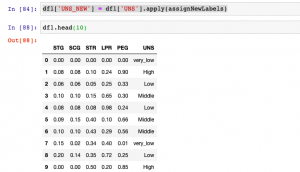
In this post, you will get a code sample related to how to assign new labels to columns in python programming while training machine learning models. This is going to be very helpful when working with classification machine learning problem. Many a time the labels for response or dependent variable are in text format and all one wants is to assign a number such as 0, 1, 2 etc instead of text labels. Beginner-level data scientists will find this code very handy. We will look at the code for the dataset as represented in the diagram below: In the above code, you will see that class labels are named as very_low, Low, High, Middle …
Difference between Adaline and Logistic Regression
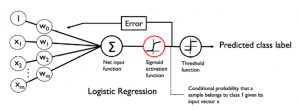
In this post, you will understand the key differences between Adaline (Adaptive Linear Neuron) and Logistic Regression. Activation function Cost function Difference in Activation Function The primary difference is the activation function. In Adaline, the activation function is called as linear activation function while in logistic regression, the activation function is called as sigmoid activation function. The diagram below represents the activation functions for Adaline. The activation function for Adaline, also called as linear activation function, is the identity function which can be represented as the following: $$\phi(W^TX) = W^TX$$ The diagram below represents the activation functions for Logistic Regression. The activation function for Logistic Regression, also called as sigmoid activation function, is …
Logistic Regression: Sigmoid Function Python Code
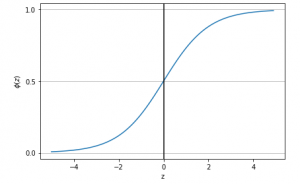
In this post, you will learn about the following: How to represent the probability that an event will take place with the asssociated features (attributes / independent features) Sigmoid function python code Probability as Sigmoid Function The below is the Logit Function code representing association between the probability that an event will occur and independent features. $$Logit Function = \log(\frac{P}{(1-P)}) = {w_0} + {w_1}{x_1} + {w_2}{x_2} + …. + {w_n}{x_n}$$ $$Logit Function = \log(\frac{P}{(1-P)}) = W^TX$$ $$P = \frac{1}{1 + e^-W^TX}$$ The above equation can be called as sigmoid function. Python Code for Sigmoid Function Executing the above code would result in the following plot: Pay attention to some of the …
Three Key Challenges of Machine Learning Models
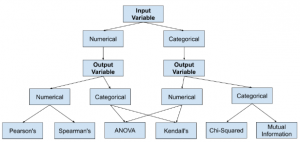
In this post, you will learn about the three most important challenges or guiding principles that could be used while you are building machine learning models. The three key challenges which could be adopted while training machine learning models are following: The conflict between simplicity and accuracy Dimensionality – Curse or Blessing? The multiplicity of good models The Conflict between Simplicity and Accuracy Before starting on working for training one or more machine learning models, one would need to decide whether one would like to go for simple model or one would want to focus on model accuracy. The simplicity of models could be achieved by using algorithms which help …
Hypergeometric Distribution Explained with 10+ Examples
In this post, we will learn Hypergeometric distribution with 10+ examples. The following topics will be covered in this post: What is Hypergeometric Distribution? 10+ Examples of Hypergeometric Distribution If you are an aspiring data scientist looking forward to learning/understand the binomial distribution in a better manner, this post might be very helpful. The Binomial distribution can be considered as a very good approximation of the hypergeometric distribution as long as the sample consists of 5% or less of the population. One would need a good understanding of binomial distribution in order to understand the hypergeometric distribution in a great manner. I would recommend you take a look at some of my related posts on …
Binomial Distribution with Python Code Examples
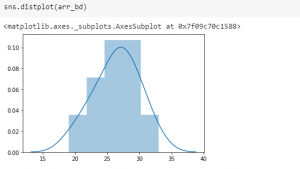
In this code, you will learn code examples, written with Python Numpy package, related to the binomial distribution. You may want to check out the post, Binomial Distribution explained with 10+ examples to get an understanding of Binomial distribution with the help of several examples. All of the examples could be tried with code samples given in this post. Here are the instructions: Load the Numpy package: First and foremost, load the Numpy and Seaborn library Code Syntax – np.random.binomial(n, p, size=1): The code np.random.binomial(n, p, size=1) will be used to print the number of successes that will happen in one (size=1) experiment comprising of n number of trials with probability/proportion of success being p. Tossing a …
Beta Distribution Example for Cricket Score Analysis

This post represents a real-world example of Binomial and Beta probability distribution from the sports field. In this post, you will learn about how the run scored by a Cricket player could be modeled using Binomial and Beta distribution. Ever wanted to predict the probability of Virat Kohli scoring a half-century in a particular match. This post will present a perspective on the same by using beta distribution to model the probability of runs that can be scored in a match. If you are a data scientist trying to understand beta and binomial distribution with a real-world example, this post will turn out to be helpful. First and foremost, let’s identify the random variable that we would like …
How to Print Unique Values in Pandas Dataframe Columns

A quick post representing code sample on how to print unique values in Dataframe columns in Pandas. Here is a data frame comprising of oil prices on different dates which column such as year comprising of repeated/duplicate value of years. In the above data frame, the requirement is to print the unique value of year column. Here is the code for same. Note the method unique()
Pandas – How to Concatenate Dataframe Columns

Quick code sample on how to concatenate the data frames columns. We will work with example of Boston dataset found with sklearn.datasets. One should note that data frames could be concatenated by rows and columns. In this post, you will learn about how to concatenate data frames by columns. Here is the code for working with Boston datasets. First and foremost, the Boston dataset will be loaded. Once loaded, let’s create different different data frames comprising of data and target variable. This above creates two data frames comprising of data (features) and the values of target variable. Here are the snapshots. Use the following command to concatenate the data frames. …
Difference between Machine Learning & Traditional Software
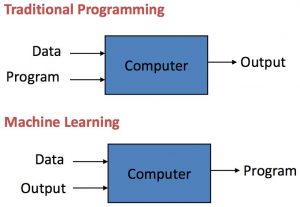
In this post, we will understand what are some of the key differences between machine learning models and traditional/conventional software. S.No Traditional Software Machine Learning 1 In traditional software, the primary objective is to meet functional and non-functional requirements. In machine learning models, the primary goal is to optimize the metric (accuracy, precision/recall, RMSE, etc) of the models. Every 0.1 % improvement in the model metrics could result in significant business value creation. 2 The quality of the software primary depends on the quality of the code. The quality of the model depends upon various parameters which are mainly related to the input data and hyperparameters tuning. 3 Traditional software …
Neural Network Architecture for Text-to-Speech Synthesis
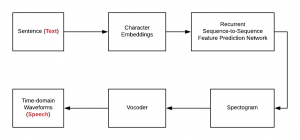
In this post, you would learn about a neural network reference solution architecture which could be used to convert the text to speech. The neural network solution architecture given in this post is based on deep learning (autoencoder network (encoder-decoder) with attention). Neural Network Reference Architecture for Text-to-Speech Synthesis In the solution architecture diagram (figure 1) depicted below, the following is described: Sentences are first converted into character embeddings. Character embeddings are numeric representations of words. Numeric representations of each of the words could be used to create numeric representations of higher-level representations like sentences/paragraphs/documents/etc. Character embeddings are next fed into recurrent sequence-to-sequence feature prediction network with attention. The sequence-to-sequence …
I found it very helpful. However the differences are not too understandable for me